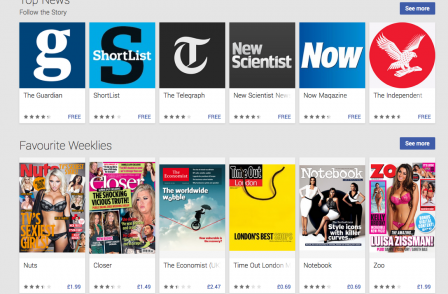
Google’s Android is now the most popular smartphone operating system in the UK – so publishers can no longer just talk about iPhone and iPad apps.
But despite its increasing market dominance (on mobile anyway) the Google proposition for publishers remains a confusing one.
In December, 2011 Google launched Currents, a service which turned a news website into a fairly slick mobile-optimised app.
In November last year Currents was killed off and instead it became part of the Google Newsstand app. So what is Newsstand and how can publishers make the most of it?
The first point to make is that Currents is still there and has been rebranded as the My News section.
So if you had a Currents site it will have moved across. If you didn’t, it is fairly straight forward to set one up via the https://www.google.com/producer website.
The advantage of My News is that it makes your website easily browsable on a mobile device, any traffic counts towards your total (via Google Analytics) and you can serve ads on it (with Google of course taking a cut).
My News can also be customised if you have a metered paywall. So the Financial Times is on My News offering seven free articles per month before it invites readers to take out a subscription.
Read Now is a new service offered as part of the Newsstand app which allows readers to scroll through a selection of mobile-optimised news content selected for them by a Google algorithm.
The Read Now app guesses what you will be most interested in based on the stories that you read.
My Magazines is the section of Newstand which incorporates the old Google Magazines app.
Here are there are a variety of digital versions of magazines for sale.
Some, like free weekly Shortlist for instance, simply offer a page-turning replica of the print magazine – which is ok for tablets, but doesn’t really work on the smaller mobile screen.
Google does offer a more sophisticated system as used by The Economist which gives readers a mobile-optimised version of the story text when they click on it.
So far I understand that in the UK there are no interactive magazines on the My Magazines service.
But magazines can, if they wish, redesign their content so that it is optimised for mobile devices.
Google’s head of news partnerships Madhav Chinnappa says: “We are a counter in a store. The publisher is giving us their content for sale, they decide what they give us for sale. We’d like to make it as interactive as possible.”
Because subscription sales via Google Newsstand are dealt with by Google itself, it has the same big drawback that Apple has. Google takes a huge cut (believed to be around 30 per cent – but it is negotiated on a case by case basis) and it also has your subscriber information.
The big advantage is that Google Newsstand is designed to be like a newsstand, so it is browsable and opens your publication up to a potentially huge new market of customers.
The Read Now service (formerly Currents) is a free way to create an app-style experience on mobiles and tablets and Madhav assures me that publishers are making money from the advertising on it.
Whereas the cost of creating an Apple-optimised interactive app for your magazine is likely to be £10k upwards, the up front cost of getting on Google magazines is zero if you are content to simply send Google the PDF files.
I'm told that anyone looking for more information about how to get their content on Google Newsstand can contact Madhav on madhav@google.com
Email pged@pressgazette.co.uk to point out mistakes, provide story tips or send in a letter for publication on our "Letters Page" blog
